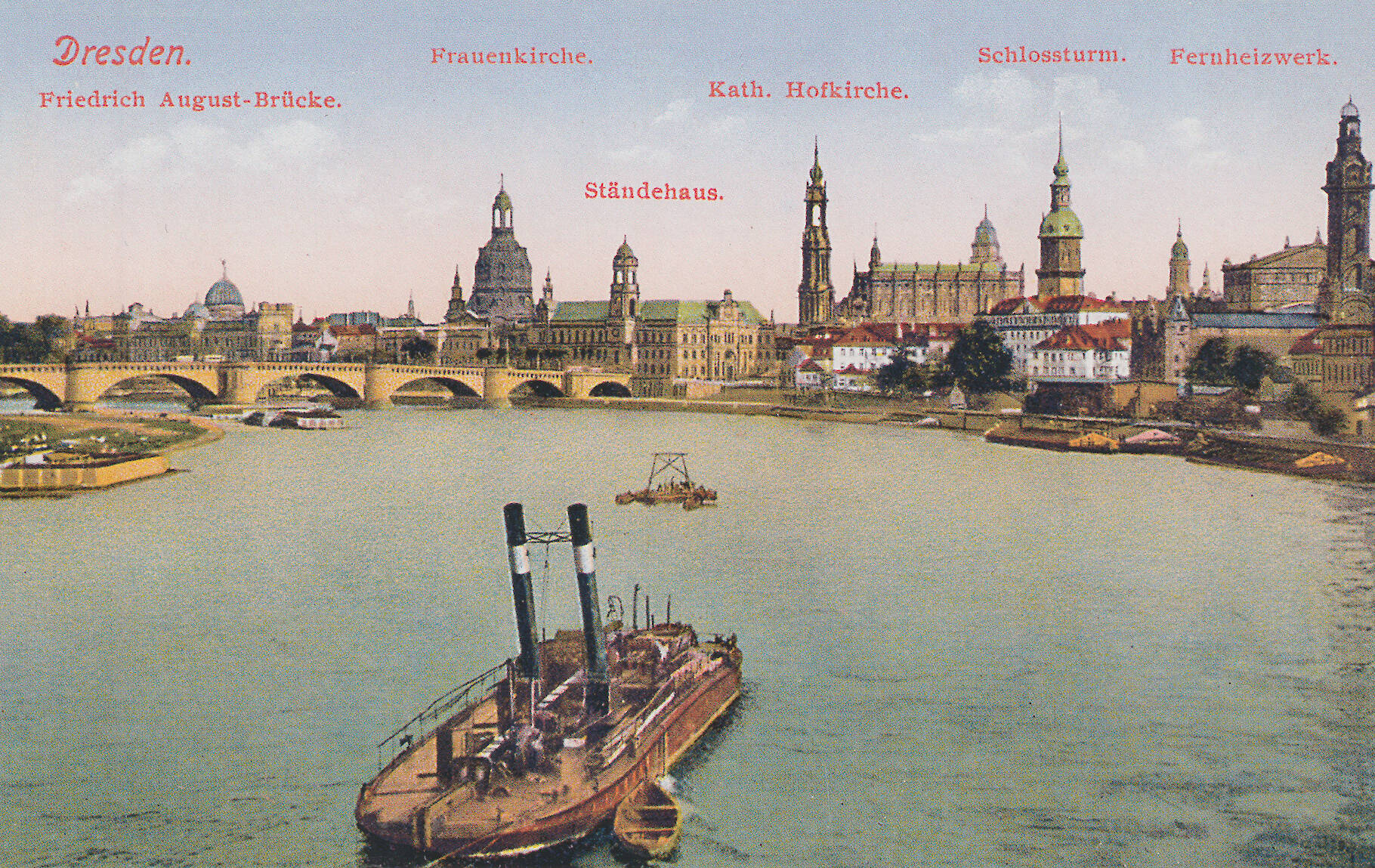
History of the synagogues
There was already a Jewish population in Dresden in the Middle Ages. In connection with the plague epidemic of 1348/49, there were severe anti-Semitic pogroms.1 Subsequently, the Jewish population was expelled several times and permanently denied settlement rights.2 From 1772, Jews were once again tolerated in Dresden with severely restricted basic rights. In the 19th century, civic equality took place step by step.3 In 1837, after difficult negotiations, the Jewish community acquired a garden plot in the city centre as a building site for a synagogue. It was bordered by the former gondola harbour and the military building yard.4 A synagogue was built there from 1838 to 1840 according to plans by Gottfried Semper.5 In the following decades, the Jewish community grew.
When National Socialists came to power, the Jewish population was arrested, discriminated against and emigrated. The synagogue was set on fire during "Reichspogromnacht" in 1938. The building burned down completely and the ruins were demolished in November 1938.6 With the bombing of Dresden in February 1945, the surrounding area of the former synagogue were also largely destroyed.
The Jewish community had been drastically reduced by the persecution under National Socialism. In 1950, the former mourning hall at the Jewish cemetery on "Fiedlerstraße" was converted into a synagogue and used as such.7 In the following decades, the congregation continued to shrink. In 1975, a memorial sign was erected in the immediate vicinity of the former site of the synagogue.8
After the political change in 1989, the Jewish community grew with people from the former CIS states. At the same time, initiatives were founded to communicate Jewish history and to build a synagogue. In 1997, an architectural competition was held for a new synagogue building at the former inner-city location. The design by Wandel, Hoefer, Lorch + Hirsch was realised and the new synagogue was consecrated in 2001.9
On 3. September 2023, the Jewish Community of Dresden opened the Dresden-Neustadt Synagogue.10
- [1] Cf. Hatikva e.V.: Spurensuche. Juden in Dresden. Ein Begleiter durch die Stadt. Hamburg 1996, p. 11.
- [2] Cf. ibid, p. 11.
- [3] Cf. Lässig, Simone: Jüdischer Alltag zwischen Wandel und Beharrung. Zur kulturellen und religiösen Praxis einer "verspäteten" Gemeinde in der Frühphase der Emanzipation. Dresden 2001, pp. 57–58.
- [4] Cf. Laudel, Heidrun: Der Bau der Synagoge in Dresden (1838–1840) – ein Werk Gottfried Sempers. Dresden 2001, p. 22.
- [5] Cf. ibid, p. 20.
- [6] Cf. Ristau, Daniel: Bruch/Stücke. Die Novemberpogrome in Sachsen 1938. Leipzig 2018, p. 75.
- [7] Cf. ibid, S. 118.
- [8] Cf. Hatikva e.V. 1996 (like note 1), p. 35.
- [9] Cf. Freundeskreis Neue Synagoge e.V.: Zur Architektur der Neuen Synagoge zu Dresden. Online (05.05.2023).
- [10] Cf. Jüdische Kultusgemeinde Dresden: Veranstaltungskalender. Online (03.09.2023).
- References »
Representation of the synagogues
There are several postcard motifs of the old synagogue as individual motifs. They were taken from the southwest or northwest. Due to the dense building development around the synagogue, it was hardly possible to take them as solitary images.
On postcards with total views of the city of Dresden, the old synagogue is hardly present. From a perspective, these were usually made from the northwest with the focus on "Brühlsche Terrasse". In this case the synagogue was not visible. In addition to this "classic view" of Dresden, there are also motifs from the north and east that would have made it possible to depict the synagogue. In fact, it is not depicted on these postcards either because of the peripheral location of the synagogue and direct competition with the topographically higher buildings arranged in a first row on "Brühlsche Terrasse". From a purely pictorial point of view, a choice of motif in favour of the synagogue would not have made sense. Several other buildings in the old town would have been cut down and the old synagogue would still have been barely visible due to its location and integration. An exception is the perspective from "Königsufer" to the Old Town, although the old synagogue is hardly recognisable there either. In the case of the new synagogue, this perspective would be significant today, as the new building is very visible due to its layout and the changed development in the surrounding area. Only a single image of the new Synagogue is currently available.
In the case of the postcard with the sculpture "Bewegte Elbe", the background was retouched. In this perspective, the old synagogue would have been visible behind the sculpture in reality.
In Dresden, the image motifs of postcards sometimes do not correspond to the actual urban planning situations at the time they were sent. This difference concerns some cards with the perspective of "Königsufer", which were sent in a time window between 1938 and 1945, when the synagogue depicted on them had already been destroyed.







